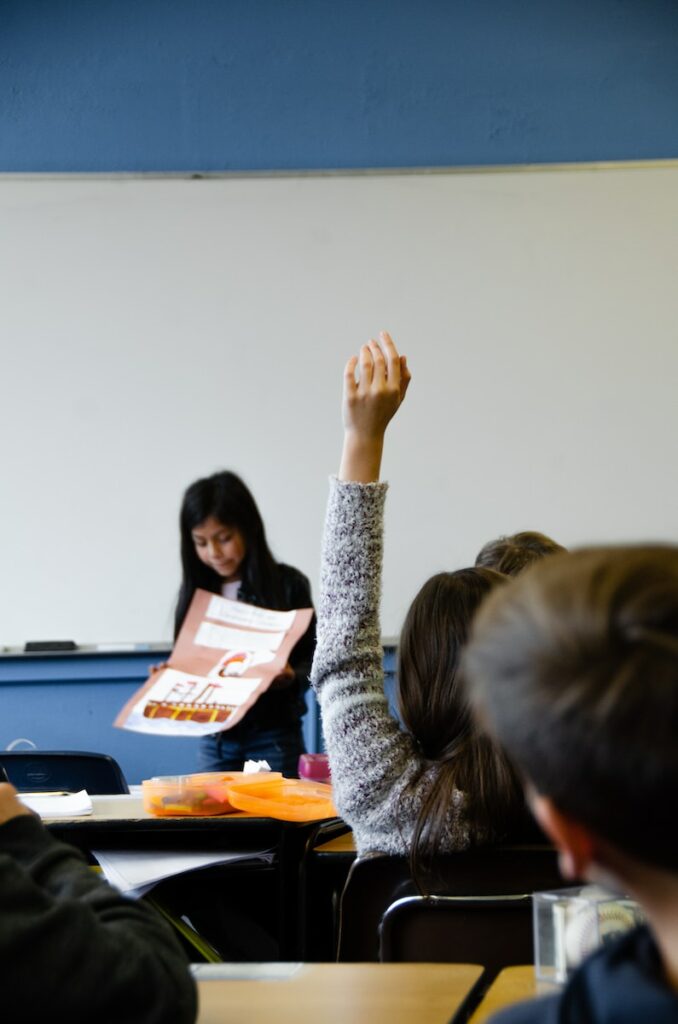In today’s digital age, unconventional tools like TikTok are revolutionizing the way we approach education and learning. You might have been tasked with writing a speech on why TikTok can be good for studying, or maybe you’ve picked this as your chosen topic.
You might even be a content creator looking to create videos on the subject.
In this post we’e put together three speeches you could pick from that have different lengths, and audiences. But besides providing you with pre-written speeches that list the benefits of TikTok in an educational context we also offer valuable tips for crafting your own persuasive speeches.
You can use these speeches as they are for presentations, discussions, or as a source of inspiration to create your own unique narrative. We do highly advise editing them so they’re unique and to bypass any plagarism checks.
Make sure to use our expert tips, as these will guide you in refining your speech-writing skills, ensuring your message is not just heard, but also resonates with your audience.

Prewritten Speech On Why TikTok Is Helpful For Studying
Ladies and gentlemen, fellow students, educators, and lifelong learners,
Today, I stand before you to discuss an unconventional yet increasingly relevant topic in the realm of education – the role of TikTok in studying. In a world where social media often bears the brunt of criticism for distracting students, I propose a different narrative: TikTok as a powerful educational tool. This might sound counterintuitive to many, but let’s delve into why and how TikTok can be an ally in our learning journey.
The Power of Microlearning
Firstly, TikTok thrives on the concept of microlearning. Each video, limited to just a few seconds or minutes, is a bite-sized piece of information. This format is incredibly effective for today’s learners who often find it challenging to maintain prolonged focus. Microlearning aligns perfectly with the cognitive science principle that our brains are better at absorbing small chunks of information at a time. Educational content on TikTok, therefore, becomes easily digestible, making complex topics more approachable and less daunting.
Diverse Educational Content
The diversity of content on TikTok is astounding. From quick math tricks and science experiments to historical facts and language learning tips, the platform is a treasure trove of knowledge across various subjects. This diversity not only caters to different learning needs but also exposes learners to topics they might not encounter in a traditional classroom setting, thus broadening their horizons.
Engagement Through Creativity
TikTok’s format encourages creativity and engagement. Educators and learners alike use creative methods to present information, whether through catchy songs, humorous skits, or visually appealing graphics. This creativity not only makes the learning process enjoyable but also aids in better retention of information. When a concept is learned in a fun and engaging way, it’s more likely to stick.
Community and Collaboration
TikTok fosters a sense of community and collaboration, which is vital in education. Users can share their knowledge, ask questions, and receive immediate feedback. This interactive environment creates a virtual classroom where learners from around the globe can connect, share ideas, and learn from each other. The hashtag system on TikTok further enhances this, allowing users to follow specific educational topics and stay updated with the latest content in their fields of interest.
Accessibility and Convenience
In today’s fast-paced world, accessibility and convenience in learning are paramount. TikTok offers just that. With just a smartphone and an internet connection, a vast array of educational content is at your fingertips, anytime and anywhere. This accessibility is particularly crucial for those who may not have the resources for traditional learning or live in remote areas.
Visual and Auditory Learning
TikTok caters to visual and auditory learners exceptionally well. The combination of visuals, text, and audio in TikTok videos addresses these learning preferences effectively. For visual learners, the vibrant and dynamic visuals aid in understanding and remembering information. Auditory learners benefit from the explanations and discussions in the videos.
Up-to-Date and Real-World Relevance
The content on TikTok is continuously updated, providing learners with current and relevant information. In a world where knowledge and facts evolve rapidly, this ensures that learners are not left behind with outdated concepts. Moreover, TikTok creators often link educational content to real-world scenarios, making learning more relatable and applicable to everyday life.
Challenges and Considerations
However, it’s important to address the challenges. The risk of misinformation on TikTok cannot be ignored. Users must be discerning about the sources of their information and cross-check facts when necessary. Additionally, the addictive nature of social media, including TikTok, calls for disciplined and mindful usage to avoid it becoming a distraction.
Conclusion
In conclusion, TikTok, when used judiciously, can be a valuable educational resource. It aligns with modern learning styles, offers diverse and engaging content, and provides a platform for collaborative learning. As we navigate this digital age, it’s imperative to adapt and embrace new methods of learning. TikTok, with its vast potential, stands as a testament to how social media can positively impact education.
Let us not dismiss TikTok as just another distraction. Instead, let’s harness its power to transform the way we learn, making education more accessible, engaging, and fun for everyone. Thank you.
Short Speech On Why TikTok Is Helpful For Studying
Ladies and gentlemen,
Today, I want to highlight an unexpected ally in education – TikTok. Often seen as a mere entertainment platform, TikTok is, in fact, a valuable resource for learning.
Microlearning at Its Best
TikTok’s short videos are perfect for microlearning. They break down complex topics into manageable, engaging snippets, making learning easier and more efficient for our fast-paced lives.
Diverse Learning Content
The platform offers a wealth of knowledge across various subjects. From science and math to history and languages, TikTok provides a diverse range of educational content, making learning both fun and informative.
Engagement and Accessibility
TikTok’s creative approach to presenting information keeps learners engaged and aids in better retention. Moreover, its global reach breaks down barriers to education, making learning accessible to all with just a smartphone.
In conclusion, TikTok is a powerful educational tool that combines efficiency, diversity, and engagement, transforming the way we approach learning.
Thank you.
Speech On Why Parents Should Let Their Kids Study With TikTok
Title: “Embracing TikTok: A Tool for Educational Advancement”
Ladies and Gentlemen, esteemed parents,
Today, I stand before you to discuss a topic that might initially seem unconventional – the educational benefits of TikTok for our children. In an era where digital platforms are often viewed with skepticism, especially by parents, it’s crucial to shed light on how these platforms, particularly TikTok, can be harnessed for educational purposes.
Understanding TikTok’s Educational Potential
TikTok, at its core, is a social media platform known for short, engaging videos. What many don’t realize is that it has evolved into a space rich with educational content. Educators, experts, and enthusiasts share knowledge spanning various subjects – from science and mathematics to history and arts. This content is not only diverse but also aligns with modern educational standards.
The Power of Microlearning
The platform thrives on the concept of microlearning – delivering information in small, digestible chunks. This method is particularly effective for the younger generation, who often find traditional methods of learning lengthy and challenging to engage with. TikTok’s short videos make learning more manageable and less overwhelming, fostering a more efficient and enjoyable learning experience.
Engagement and Creativity
One of TikTok’s greatest strengths is its ability to engage users creatively. Educational content on TikTok is often presented in a fun, relatable, and visually appealing manner. This creative approach not only captures the attention of young learners but also aids in better retention of information.
Accessibility and Flexibility
TikTok offers unparalleled accessibility. Learning can happen anytime and anywhere, breaking down the barriers of traditional classroom settings. This flexibility is particularly beneficial for reinforcing concepts learned at school or exploring new interests and skills beyond the curriculum.
Fostering a Community of Learners
TikTok has cultivated a global community where learners can interact, share experiences, and collaborate. This sense of community is vital in encouraging peer-to-peer learning and support, further enhancing the educational experience.
Addressing Concerns
As responsible parents and guardians, it’s natural to have concerns about screen time and content quality. It’s important to approach TikTok as we would any educational tool – with guidelines and supervision. Setting boundaries on usage time and monitoring the content ensures that the platform is used positively and productively.
Conclusion
In conclusion, TikTok, when used responsibly, can be a valuable addition to our children’s educational toolkit. It offers a unique blend of engagement, creativity, and accessibility, making learning not just effective but also enjoyable. By embracing this platform, we are not just opening doors to new ways of learning but also showing our children that we understand and respect their world.
Let’s not dismiss TikTok as merely a source of entertainment. Instead, let’s recognize its potential as a powerful educational resource, one that can complement traditional learning methods and prepare our children for a rapidly evolving digital world.
Thank you.
Tips For Writing A Great Speech

- Understand Your Audience: Tailor your speech to the interests, level of understanding, and background of your audience. Knowing who you are speaking to will help you choose the right tone, language, and examples.
- Define Your Purpose: Clearly identify what you want to achieve with your speech. Are you informing, persuading, entertaining, or motivating your audience? Your purpose will guide the structure and content of your speech.
- Start Strong: Capture your audience’s attention from the beginning. Use a compelling quote, a startling fact, a question, or a brief story to engage them right away.
- Organize Your Ideas: Structure your speech logically. Start with an introduction, followed by the main body where your key ideas are presented in a clear, concise manner, and conclude with a strong closing that reinforces your main message.
- Use Clear and Simple Language: Avoid jargon and complex language. Use simple, clear words to ensure your message is easily understood.
- Be Concise: Respect your audience’s time. Keep your speech focused and to the point. Remove any unnecessary information that does not contribute to your main message.
- Use Stories and Examples: People relate to stories and examples more than abstract ideas. Use them to illustrate your points and make your message more memorable.
- Vary Your Voice and Pace: Use changes in volume, tone, and speed to keep your audience engaged. Monotone speeches can be dull and lose the audience’s attention.
- Practice, Practice, Practice: Rehearse your speech multiple times. This will help you become more familiar with your material, reduce nervousness, and improve your delivery.
- Engage with Your Audience: Make eye contact, use gestures, and ask rhetorical questions to create a connection with your audience. A speech is a two-way interaction, and audience engagement is key to its success.